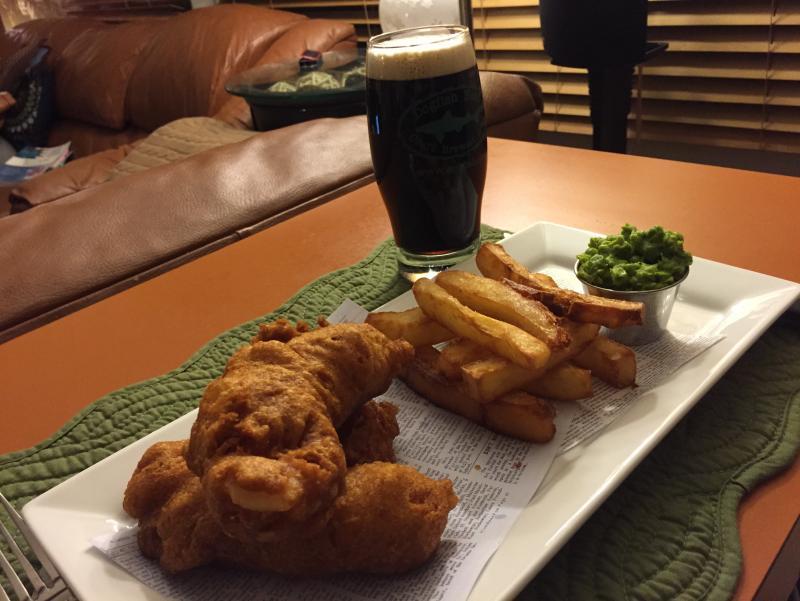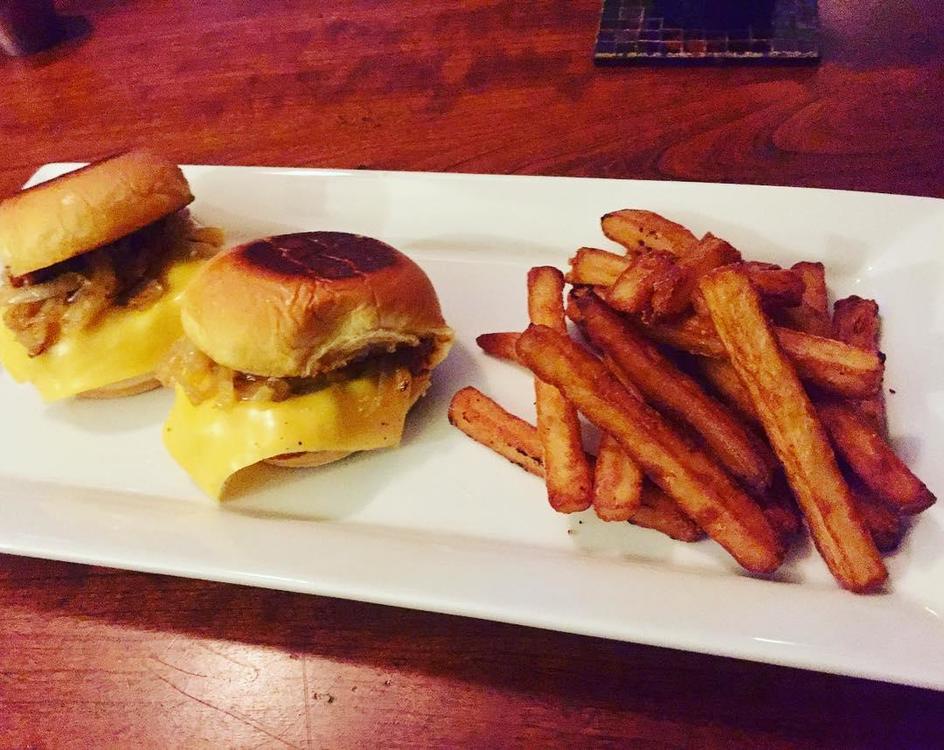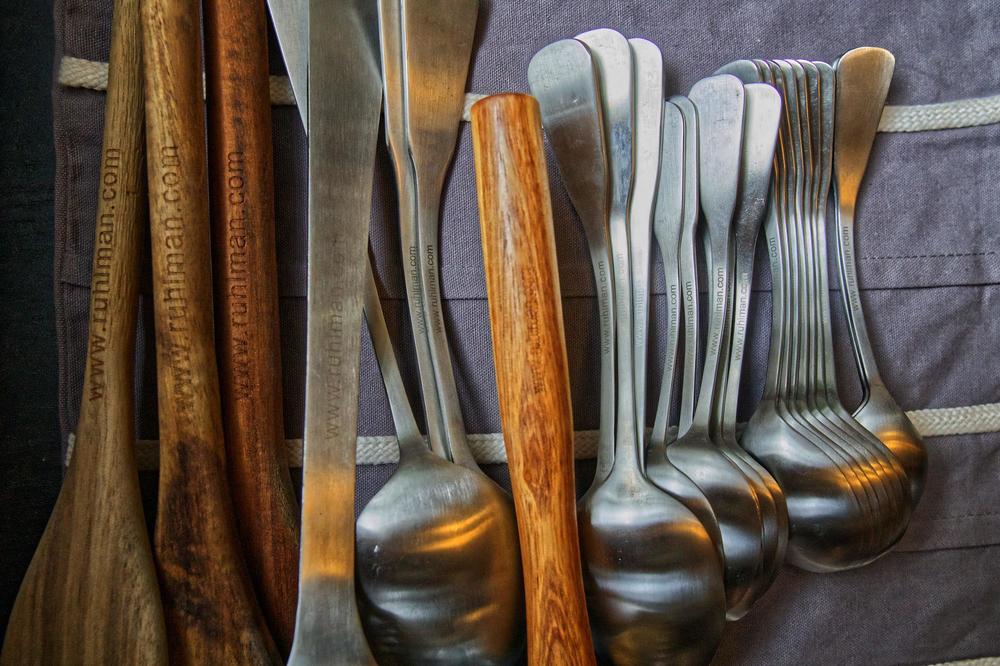-
Posts
1,807 -
Joined
-
Last visited
Content Type
Profiles
Forums
Store
Help Articles
Everything posted by btbyrd
-
There is no "best" or "correct" way to do anything. There are just better and worse paths to specific goals. But I don't think that you fell into that trap. The Platonic metaphysics have corrupted our thinking about value in so many domains... but the quest for the One "best" way to do _________ in the kitchen is one of the most obvious. This is a stupid quest. There is no Platonic form of the French Fry that our methods are failing to live up to. There's just a bunch of techniques to do particular things to achieve some desired result. All of them involve trade-offs. All of them are better and worse in various respects. None are "best." None are "correct." I wish we'd all stop thinking like Platonists about value in the kitchen. It'd take a big weight off our shoulders and free our minds to explore the world of culinary technique free of guilt and shame. Some outlets have built their brand on Platonic "best-mongering." They shell out recipe after recipe for "the best roast chicken" or "the best pumpkin pie." They're hoping that you're afraid in the kitchen. Afraid of not living up to that BS Platonic ideal. Because they've got a solution to sell you. They're counting on your fear. They might not know that's what they're doing, but that's what they're doing. And they need to knock it off. We have enough neurotic cooks as it is.
-
If you haven't tried the modernist triple cooked chips, you're missing out. Heston invented it, but there are a bunch of variations out there. I started out with the ChefSteps version, but now have my own approach. Start with Russet or Maris Piper potatoes (depending on where you are). The technique begins with an initial blanching step to cook the potato and wake up the starches. You want to cook them until they are almost falling apart (and some will fall apart). Doing this in a water bath is more gentle because there's less agitation and bumping around; you'll break fewer fries if you blanch them sous vide, but if you don't care then that's not really necessary. Half the time, I just boil them on the stovetop. If I'm feeling precious, I'll go all-out. Everything's a trade off. Anyway, after the initial blanch, the fries are drained and allowed to dry. The easiest thing to do is move them to a rack, let them cool down to room temp, and then move them to the fridge to let the surface moisture flash off. Then there's a low-temp fry step. You fry the blanched potatoes at a low temp (like 275F/130C) to start to set the crust and to drive out moisture. Once that's done, you drain the fries, allow them to cool, and then freeze them. From frozen, it's just a quick trip through some hot oil. By the time the outside looks done, the inside will be thawed. And delicious. That freezing step is cool because it allows you to do all this pain-in-the-butt work before hand in a big batch, and then you have fancy modernist fries in your freezer ready to deep fry at your leisure. That's the only way I can justify doing all that work (unless it's for a special occasion or something). There are a lot of variations in this framework. People have put their fries in vacuum chambers, ultrasonic baths, and enzyme solutions to try to produce a maximally crusty and delicious surface. I've tried two of those three, and found the Pectinex SPL pre-soak on the raw potatoes to be the cheapest, easiest way to enhance the surface texture. That's Dave Arnold's trick. But it's not really necessary. None of the fussy Modernist epicycles are really necessary to pull off a delicious triple cooked chip. Just follow the formula: blanch/boil, fry, fry. Examples: 3X Cooked Chips with Methocel F50 battered fish. This was a lard fry, if I recall correctly. . Here are some sliders and fries. I made the slider patties from some freshly ground pastured chuck. Then I froze them. The "pickup" on this meal was to deep fry the fries, then deep fry the burgers. I used my late grandmother's french fry cutter instead of a knife on this one. It is not the best version of that tool, but it keeps the dream alive, so to speak. Here's a ChefSteps iteration doing thin-cut fries. They have a recipe for the thick-cut ones as well. Fry fry fry, agent Starling... Fry fry fry...
-
Brand new oil is actually not as good as "older" fry oil, as slightly heat-damaged lipids are better at making physical contact with the surface of food (I believe for ionic reasons, if I recall my Dave Arnold correctly). At any rate, brand new fry oil isn't ideal for producing a brown crust as easily. That's not why I save my oil... but it's a good story to tell to myself while I'm filtering the oil and putting it back in the jar. I "backslop" old oil back into the main container, but only if it's been used to fry clean-tasting foods like potatoes. If fish or brassicas or some other such thing got fried in there, I end up disposing it. I use high oleic sunflower oil for most of my deep frying needs. It hits the right balance between having a healthy lipid profile, high smoke point, neutral flavor, and relatively low cost. There's probably something better out there, but I haven't had the time (or the need) to explore the options in depth. Most industrial seed oils used for deep frying are a freaking nightmare on your body from a health perspective (though that's a matter for another forum). I also like to use lard and tallow from pastured pigs and cows. For different reasons, and for different applications. The flavor of french fries made in beef tallow is superb. Apparently, if Steingarten is to be believed, a mixture of half horse fat and half beef fat tastes even better. But that beef fat french fry flavor is the core of the OG McDonald's french fry -- the Original Platonic Form of the French Fry in the American imagination. That was before the damned vegetarians and their health-nut disciples forced an industry-wide switch over from saturated animal fats to hydrogenated vegetable oils. Stupid jerks. How'd that work out for us? Want to ban trans-fats now? Guess who brought those into our dietary system, jerks!!! But I digress.... Lard also makes good french fries. Great onion rings. But it's the bee's knees for fried chicken. Chicken fried in lard? Yes. Throw in some fresh bacon fat and some rendered fatty funk from a country ham? Hell yes. Lard has a lot of monounsaturated fats compared to tallow, which makes it much more fragile from a heat stability standpoint. You can't reuse it over and over like you can with tallow. But if you're making fancy fried chicken for family supper on a Sunday afternoon? Boy howdy, get you some lard and get frying. You may well have to throw the fat away afterwards... but to think of the spent fat as "waste" is to have missed the magical work it did for you.
-
I bought a leather welding apron with no pockets for using LN in the kitchen. And some cryo gloves. Need some new shoes to complete the ensemble...
-
Elastomer/rubber boards are harder on your edge than the polyvinyl acetate in Hi Soft boards, but they are more durable and can stand up longer without needing to be resurfaced. They're both good choices, but Hi Soft is the softest and most forgiving on your edge. Neither are dishwasher safe, so in a home environment where you're not going to be really hammering on your board it makes sense to opt for the softer material. Both are going to be way better than cheap plastic boards that people might be used to. I have an end grain butcher block, but I cut on Hi Softs literally all the time because it's (1) softer and (2) easier to clean. While end grain cutting boards are nice and all, they're mostly expensive art objects. Not that there's anything wrong with that. I have knives that are arguably more "expensive art object" than utilitarian cutting device. But sometimes niceness gets in the way of functionality, and I think that end grain boards are one of those times. Or at least they can often be. To be sufficiently robust, end grain boards need to be over an inch thick, and that kind of weight adds up quick. It's not pleasant to move even medium sized end-grain boards to and from the sink. Maybe I'm just a hater, but I think I'd rather stick with my super soft synthetic boards for actual cutting and save my nice wooden boards as serving boards for cheese, charcuterie, and roast meats.
-
Hinoki boards aren't good all-arounders because the wood is fussy to care for. Most quality end grain boards will cost you. If you want something that will be gentle on your steel while being easy to care for and sanitize, look into Hi Soft boards. I end up using them more than my end grain boards out of convenience, but they're also gentler on edges than wood is. Hi Soft boards aren't pretty to look at, but they're one of the best cutting surfaces available.
-
If I'm doing anything serious, the apron will usually come out. The primary advantage of an apron, for me, is that it gives you the ability to strap a side towel to your... side. It's also helpful in keeping you clean, but I don't often get food on myself when cooking. Baking or pasta making is another story -- anything with flour demands an apron. All of this is for "back of house" work. There are a lot of beautiful high-end aprons out there that I find attractive but would never buy because they're impractical to clean. Leather... denim... waxed canvas... gorgeous stuff that you either can't launder or wouldn't want to (denim). Useless materials for the cook. Front of house? Bartenders? Sure. Perhaps if you're a woodworker or a barber or a bladesmith, something like that might be useful. But I'd hate to wear one while cooking.
-
I own a Vollrath Mirage Pro which has 100 power levels and allows you to set the temperature control in 5 degree increments. I have owned cheap units that had 10 or 15 power settings, and while they were okay for some things, the lack of a finely graded temperature control made them awful for any task where semi-accurate temperature control is desired. This happens more often than you might expect. The biggest bugaboo in this department is maintaining a simmer (and, by extension, maintaining pressure in a stovetop pressure cooker). If all you have is 10 settings, your ideal temperature might be somewhere between 1 and 2, or between 3 and 4... or whatever. If you select the low setting, the bubbles will die down completely; if you select the higher number, the pot will reach a full-on rolling boil. If all you have is a binary between "no bubbles" and "rolling boil," you're going to have a bad time. Another place that having fine control is useful is at the lower end of the temperature spectrum, like for tempering chocolate or cooking eggs. Vollrath makes a big deal about the Mirage's ability to melt chocolate at like 85F (or whatever). I don't do pastry/chocolate, so I can't comment there... but I do appreciate the ability to dial down my pot or pan to a very low setting for various applications. And while the temperature control (versus the 100 level power settings) on the Vollrath isn't the most precise, it's usefully spot on in the magic egg-cookery range of 60-70C. At 60C with a very thick (and well pre-heated) pan, eggs will just barely cook -- you could walk away for 15 minutes and they'd be slightly thickened from the base, but not much else. At 65C, they thicken and cook very gently -- give them a stir every three minutes or so over thirty minutes, and you'll have perfect custardy bain marie style eggs. At 70C the eggs cook much more quickly, but still yield a nice slow scrambled style (just with a much tighter curd). At any rate, having 100 power levels is fantastic. But it would be less fantastic if these weren't tied to a hardware knob (or rotary encoder, in this case). Membrane switches on induction are a freaking nightmare. Do you want to poke at a panel 100 times to adjust the temperature? Or sit there and wait while you hold your finger down on the button? It's awful. 100 levels of power are useless if they're locked behind switches. You need a knob so you can crank things up or throttle them back quickly and easily and without having to look at a display while you fiddle with membranes. Apart from having a highly granular access to the unit's maximum wattage via some sort of knob/dial, the other important thing to develop is accurate temperature control. 1-100 is great for some applications, actual temperature control is better in others The units to beat with respect to temperature control are the Polyscience/Breville Control Freak and the burners from Hestan. Having a temperature sensor in the cooktop as well as a wirelessly connected temperature probe seems like the way to go there. That could be an upgrade/upsell, because not everyone would be interested. But there is no other induction unit under $1000 (basically) that has 100 temperature levels apart from the Mirage Pro, and the Mirage Pro is targeted exclusively at commercial audiences. Home consumer use invalidates the warranty, which is stupid. So the market is wide open for a quality induction burner with a lot of control at a reasonable price for a home consumer market. Wide open. The world doesn't need another garbage induction hob. What it needs is something that can sell for $200-ish with a big induction coil, 100 power settings, a knob, and a $50 bluetooth temperature probe that works in conjunction with a temp sensor in the base to deliver extremely stable PID-based temperature control. Shoot for that, or something very close to that. Anything else is a waste of your time (and everyone else's).
-
I love mine, but also can't imagine the hassle of trying to ship it. Someone in Boulder should snatch this up!
-
Zingerman's is having their spring sale, which includes some bacon products. I stocked up on some apple and cherry smoked Neuske's bacon. I'm looking forward to having it again -- it's been years! The first true country bacon experience I ever had was Neuske's purchased direct at Zingerman's deli in Ann Arbor. My life would never be the same...
-
It came with a steel pan/plate thing to put under it, but sometimes I use a ceramic plate similar to what's pictured in Nickrey's photo. You could use just about anything... and could probably get away with using nothing at all, depending on the surface.
-

Ruhlman / Dalton Spoons, Utensils, and Kitchen Accessories
btbyrd replied to a topic in Kitchen Consumer
Engraved kanji are one thing. Links to your website is another matter entirely. I have thought about bead blasting the "Richmond" off of the Richmond spoon. But I do hate having to put labor into a new purchase to make it look like it should. Especially if it's just a freaking spoon. -

Ruhlman / Dalton Spoons, Utensils, and Kitchen Accessories
btbyrd replied to a topic in Kitchen Consumer
While it's bad, it's not *that* bad. And the spoons aren't priced like luxury tableware, so I'm willing to cut it some slack. Ruhlman should still figure out something better in the future. This isn't an uncommon problem. Mark Richmond from Chef Knives to Go makes some nice knockoff versions of the Kunz spoon, and he had some damascus ones made. They're pricey at $40, but I'd totally pay that for an etched damascus Kunz spoon equivalent. But I will not be buying any of them with the Richmond logo on the back. I'd accept a small "CKTG" or something. But this is dealbreakingly unattractive: Kunz's spoons say "Gray Kunz 18/10" on the back, but it's small and tasteful and perfectly in line with industry norms for branding flatware. No giant text; no URLs. -

Ruhlman / Dalton Spoons, Utensils, and Kitchen Accessories
btbyrd replied to a topic in Kitchen Consumer
-
I intended to be a good person and break the table down when I'm finished using it, but I've left it outside for months at a time through rain and snow. I think it's been outside for the past three months, as a matter of fact. It's weathered the weather well, but it's not really built to be used outdoors permanently. I'm sure it would hold up outside for a couple of years in most climates pretty well, but the tabletop part that rolls up is held together by bungee cord-like material. It's probably super durable stuff, but that's the part of the table that I suspect would eventually fail (since everything else is aluminum, except for a couple of plastic end caps). And +1 on jmolinari's observation about these burners rusting. Mine started rusting being left outside overnight simply from the condensation. Good tip about the exhaust paint.
-
I use a small square ALPS Mountaineering collapsible aluminum table. The legs fold and the tabletop rolls up, and the whole thing fits in a bag. They're good for camping and tailgating or wherever you might need a popup table. It's a good height for wokking while standing. I also use it with my konro. Not at the same time, of course... but as you can see, there's ample room even on the small one. We go enough places with enough stuff that having an extra table like this is extremely useful. They make a slightly larger size for not much more money, as well as giant picnic table type things. I could see any or all of them being useful for a catering operation, or for cooks like me who want a big backyard kitchen, but can't have everything out all the time. There are many other styles of packable table on the market. This one is fine, but it's not super heavy duty. Check out these reviews to see what the competition looks like.
-
I'd be curious to hear how it performs for yakitori. I've wanted to try one of these just to see how hot they get and what the experience of wokking is like on them. They also look like they might work well to cook with clay cookware/donabes. Sure, butane burners are cheap, inexpensive, and super portable. But there's something about pulling a huge meal together using nothing but charcoal really appeals to me. Let us know how yours works for chicken, or whatever else you end up using it for. I treated myself to a Japanese konro last year. Prior to that, I'd just been putting lump charcoal in a hotel pan and using a stainless steel cooking rack as a net. It sort of worked.The airflow in your bucket looks like it'd work a *lot* better than the janky setup I was using. Please report back.
-
Since Import Thai Food stopped selling their propane powered burner, this bucket-style charcoal-fueled wok burner is all they offer. I've always been curious as to how they're constructed... and here's an explanation!
-
I got Rambo as an all-in-one outdoor burner and it's served me well enough, though I can't say that I've used it for any non-stirfry tasks apart from getting my large stock pot up to temp in a hurry. But based on what I observed, it'll work just fine for big pot stuff like low-country boil and clam bakes. Deep frying should work as well, but I've only deep fried in a wok. Maybe one of these days I'll do the turkey thing myself... but for almost everything else, wok frying is a great way to fry. Because of the shape, you're able to fry larger items (like whole fish) in a relatively small volume of oil, and given the power of the heat source, the oil temp's recovery time after you add your product can be very short. The shape is also nice because you don't really have to worry about throwing in product and having the oil/steam bubble over on you. I also just like fying outside, because deep frying in my ventless kitchen makes my entire house smell like "fried." Anyway, I suspect you'll be just fine using a wok burner as an all-in-one. Its worked for me thus far.
-
I have one. It's nice. I don't know if it's "$24 nice," but it's essential if you're going to cook in a large vessel like the "classic" industry standard Cambro that everyone uses with Polyscience units. I'd agree with the Amazon review in that Big Clamp does sort of feel like an accessory that should just come with the circulator when you buy it. The Big Clamp was always a planned feature, as the "interchangeable clips" system was one of Joule's selling points. But the rollout of Big Clamp had some missteps. They must have run into some problems getting it produced because it took (what felt like) forever for it to finally come to market. They first teased the prototype of the clamp in their "Game of Thrones feast" YouTube video, where they use Joule to cook a suckling pig in a Yeti cooler. (I prefer Pelican coolers, but whatever.) That video came out months before Joule even shipped, so I had the expectation that the clip would be available pretty much when Joule was available. Nope. The nice thing about Joule as it comes from the factory is that you can cook in small vessels and not have to use a big old hot tub like you did with the old circulators. The downside was that there is no good way to use Joule with the kinds of containers traditionally used to cook sous vide (biggish Cambros and Lexans), much less large coolers for your sous vide suckling pig needs. I had my Joule for six months before the Big Clamp finally made it to market, and the lack of Big Clamp drove me nuts. My ultimate workaround was to take a can of beans, remove the paper label, stick Joule to the can with the magnet, and then use that as an anchor in the Cambro. I was pretty pissed off about the situation. When The Big Clamp became available, I placed my order literally within seconds of the announcement. I think they sold out the first batch in record time, if memory serves. Probably because everyone had been waiting half a year to use their Joule in a big Cambro without having a freaking can of beans stuck to it. Anyway, you asked about Big Clamp, not The Rollout of Big Clamp. And the good news about the actual clamp is that it has a high build quality and the sort of excellent design you'd expect from the people who brought us Joule. Using the clamp with large containers is super easy -- it's easily the best "circulator attachment device" I've seen. It's light years beyond the agonizing "screw it on" clamps found on many popular brands. It does make Joule take up more space in a drawer if you leave the clamp on all the time, but it's so easy to swap them in and out that this is almost a non-concern. I paid $19 for it, and would gladly do so again. I might even pay $24. In part, that's because the clip is well constructed. In part, it's because the alternative is a can of beans.
-
I was born and currently live about 30 minutes from Food Lion's corporate headquarters in NC. In my experience, they're inferior to every other major grocer in my region. Whenever I enter a Food Lion it feels like I'm going back in time. And not in a charming way. Each week, I shop at a variety of grocery stores in accordance with their comparative virtues... Harris Teeter, Whole Foods, Publix, Trader Joe's, and Walmart are my primaries, but others are sometimes also in the mix if I'm in the neighborhood. There are four Food Lions in this geographic region, and I frequent none of them. They all feel like a giant step down compared to the competition. Food Lion's primary marketing strategy over the years has been to compete on the basis of price. The only things going for it are the occasional weekly sale items on processed food items (corn-wheat-soy soda/snacks/garbage). None of the Food Lions in my area have a decent produce section, and I'd never purchase meat (or seafood) from someone who can't be bothered to properly sell vegetables. And there was a scandal about Food Lion and food safety from the 90's that I'm old enough to remember. While that's some old news, the Food Lions 'round my parts haven't stepped up their game enough in the subsequent 2.5 decades to gain my trust. The Internet reports that Food Lion operates in 10 states. Perhaps things are different in far away lands, but here on the homefront, things are rather dismal. I know this isn't the case in all markets. I've been to some decent Food Lions up in the mountains where the local Food Lion is basically the only store in town. But in my neck of the woods, which is also Food Lion's neck of the woods, they're kind of a horrorshow.
-
This woman is so freaking gangster, I don't even have words. Since there are no words, here are some videos making food for the Spring Festival and the Year of the Pig. And here's a non-cooking video where she goes out into a bamboo forest, cuts down some trees, and turns them into furniture. I cannot stop watching.













